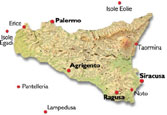|
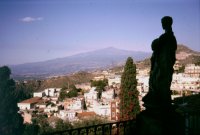 I lived in Taormina for about four months in 1993 (July, then September to December), as guest of Miss Daphne Phelps [1911-2005] at Casa Cuseni. As I was on sabbatical, I spent much of my time working on my translations of Euripides (available on this website), and this was an ideal, and idyllic place to work - conscious of the other books that had been written by guests at the house. I returned in 2001, staying in a hotel on the beach overlooking Isola Bella. I can say that from late October (after the rains) until March (when the tours begin) it is a most agreeable place, occupying a natural shelf 1000 feet above the sea, curving round a mountain. It has been there since the Greeks - there are many traces of the classical town of Tauromenium, established in 396/5 BC. (the so-called naumachia is the most important after the theatre). It was the birthplace of the historian Timaeus. I lived in Taormina for about four months in 1993 (July, then September to December), as guest of Miss Daphne Phelps [1911-2005] at Casa Cuseni. As I was on sabbatical, I spent much of my time working on my translations of Euripides (available on this website), and this was an ideal, and idyllic place to work - conscious of the other books that had been written by guests at the house. I returned in 2001, staying in a hotel on the beach overlooking Isola Bella. I can say that from late October (after the rains) until March (when the tours begin) it is a most agreeable place, occupying a natural shelf 1000 feet above the sea, curving round a mountain. It has been there since the Greeks - there are many traces of the classical town of Tauromenium, established in 396/5 BC. (the so-called naumachia is the most important after the theatre). It was the birthplace of the historian Timaeus.
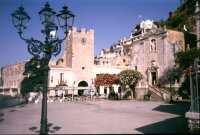 In many ways this is the least Sicilian place in Sicily - it's crowded with tourists for most of the year, the shops are more appropriate to Rome or Florence: if you prefer an "island in the sky" (title of a rather dull book on Taormina), I'd offer Erice, or the more lively Sciacca on the southwest coast between Licata and Agrigento. (There the piazza is full each evening of local families strolling, grouping and regrouping, and it has its own festivals and carnival - for the people themselves, not as an "attraction") . But still there is much that appeals about Taormina - the Corso Umberto (out of season); the Giardino Pubblico; the way its contours make the town resemble a gigantic snakes-and-ladders board; the views: over the sea - Syracuse is visible on a clear day - and towards Etna (always there, but always different as light, wind and weather bring the changes); the walk up to Castelmola; the old fashioned grandeur of the Hotel Timeo and the San Domenico Convent, now an equally grand hotel; the cable-car down to the beaches at Mazzarò and Isola Bella In many ways this is the least Sicilian place in Sicily - it's crowded with tourists for most of the year, the shops are more appropriate to Rome or Florence: if you prefer an "island in the sky" (title of a rather dull book on Taormina), I'd offer Erice, or the more lively Sciacca on the southwest coast between Licata and Agrigento. (There the piazza is full each evening of local families strolling, grouping and regrouping, and it has its own festivals and carnival - for the people themselves, not as an "attraction") . But still there is much that appeals about Taormina - the Corso Umberto (out of season); the Giardino Pubblico; the way its contours make the town resemble a gigantic snakes-and-ladders board; the views: over the sea - Syracuse is visible on a clear day - and towards Etna (always there, but always different as light, wind and weather bring the changes); the walk up to Castelmola; the old fashioned grandeur of the Hotel Timeo and the San Domenico Convent, now an equally grand hotel; the cable-car down to the beaches at Mazzarò and Isola Bella 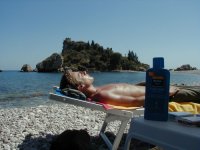 (beaches in the sense of places where you sun yourself in designer beachwear, rather than swim - it's very stony) - and the general air of order and calm. It's also one of the very few towns in the world to have a piazza and a street named after a man (von Gloeden) who won international fame with his homoerotic photographs (of local "shepherd boys" - still available as postcards in the Corso). My favorite occupation was sitting on a ledge in the Piazza XI Aprile outside the Duomo reading the paper alongside the other old men in their coppole - waiting for the Archpriest, normally to be found taking coffee in the cafe opposite, to shout abuse at exiguously-dressed tourists entering his church. (beaches in the sense of places where you sun yourself in designer beachwear, rather than swim - it's very stony) - and the general air of order and calm. It's also one of the very few towns in the world to have a piazza and a street named after a man (von Gloeden) who won international fame with his homoerotic photographs (of local "shepherd boys" - still available as postcards in the Corso). My favorite occupation was sitting on a ledge in the Piazza XI Aprile outside the Duomo reading the paper alongside the other old men in their coppole - waiting for the Archpriest, normally to be found taking coffee in the cafe opposite, to shout abuse at exiguously-dressed tourists entering his church.
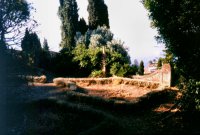 Daphne Phelps, the Englishwoman who owned Casa Cuseni where I stayed, has written entertainingly of her experiences in Sicily in her book "A House in Sicily". It was built by her uncle Robert Kitson - who combined considerable inherited wealth with a delicate constitution, necessitating his living somewhere warmer than Yorkshire. Having the whole Mediterranean to choose form, he decided to build his house outside Taormina: now it overlooks the apartment blocks that have proliferated here as everywhere - then it had a view of just the sea and Etna, and the hills between. He designed it himself - and it was decorated by artist friends (Frank Brangwyn did the dining room with its huge paintings on the walls and great round table). Daphne came out to sell the place after her uncle's death in 1948, but fell in love with it and with Sicily. The sale fortuitously fell through (see Bronte) and she stayed for over 50 years. To make ends meet she ran the house as a locanda (lodging house) - her guests included Bertrand Russell, Tennessee Williams, Roald Dahl, Caitlin Daphne Phelps, the Englishwoman who owned Casa Cuseni where I stayed, has written entertainingly of her experiences in Sicily in her book "A House in Sicily". It was built by her uncle Robert Kitson - who combined considerable inherited wealth with a delicate constitution, necessitating his living somewhere warmer than Yorkshire. Having the whole Mediterranean to choose form, he decided to build his house outside Taormina: now it overlooks the apartment blocks that have proliferated here as everywhere - then it had a view of just the sea and Etna, and the hills between. He designed it himself - and it was decorated by artist friends (Frank Brangwyn did the dining room with its huge paintings on the walls and great round table). Daphne came out to sell the place after her uncle's death in 1948, but fell in love with it and with Sicily. The sale fortuitously fell through (see Bronte) and she stayed for over 50 years. To make ends meet she ran the house as a locanda (lodging house) - her guests included Bertrand Russell, Tennessee Williams, Roald Dahl, Caitlin 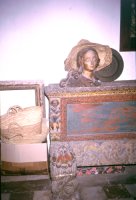 Thomas, D H Lawrence - many of whom figure in anecdotes in her book. During WW2, the house was commandeered first by Germans, who left a bullet-hole in a painting, then by British officers who put lipstick on a bust of Mary Magdalene (still visible!). Among those British officers was my uncle Gordon Moncrieff Wilson, who fought with the Green Howards. Also present in the house at some stage in the war was the broadcaster Alan Whicker - then an 18-year old member of the Army Film and Photo Unit. Thomas, D H Lawrence - many of whom figure in anecdotes in her book. During WW2, the house was commandeered first by Germans, who left a bullet-hole in a painting, then by British officers who put lipstick on a bust of Mary Magdalene (still visible!). Among those British officers was my uncle Gordon Moncrieff Wilson, who fought with the Green Howards. Also present in the house at some stage in the war was the broadcaster Alan Whicker - then an 18-year old member of the Army Film and Photo Unit.
The garden - over several acres - is a particular feature, from the papyrus fountain by the road-gate to the swimming pool above the house - empty alas since World War 2,It was designed to reflect Etna by moonlight - unimaginably romantic! Now it simply accumulates rainwater, which has to be pumped periodically into the great cistern (possibly ancient) beneath the terrace: the secret of Daphne's garden (along with the four discreetly located compost heaps), along with three wells which date back to the Greeks. Almost certainly there would have been a villa on the unique site. The garden has fruit trees - including an Avocado planted from a seed left by a US serviceman - which bore its first edible fruits while I was there, and a wonderful Persimmon (whose thin-skinned golden globes the Sicilians call kaki). When a tree has lost its leaves in autumn and the fruit is still there (some of it!) you are reminded of the Golden Apples of the Hesperides. The "Sharon fruit" from Israel is a very distant relative. I spent many hours in my "penthouse" (a living room/bedroom and a kitchen/dining room separated by a space of roof - ideal for sitting and dining when warm - although I sometimes found myself stranded in one room or the other when the weather was foul. It was an excellent vantage-point to watch the changing faces of Etna (as snow slowly spread down the slopes from October onwards), and the spectacular weather effects - sometimes so clear you could see 50 miles down the coast to Syracuse, sometimes the whole of the town below and the sea would be covered in mist- an effect like being in a plane above the clouds: and the thunderstorms were the most spectacular I've ever seen. Occasionally there was a major power cut - the view at night would then resemble what Don Roberto must have had 80 years before.
Daphne left the house to her family - nephews and nieces. Unfortunately they have been unable to agree on its future, and is currently (January 2011) for sale (a mere €2,200,000).
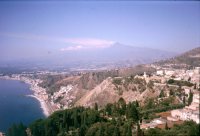 Visitors come to Taormina for the whole experience, not individual sights - apart from the Graeco-Roman theatre, star of a thousand travel posters. The views from it are indeed amazing, but no better than from my rooftop at Casa Cuseni. The Greeks originally built it with the natural backdrop of Etna and the sea, which the Romans cunningly concealed with a vast curtain wall. The columns, incidentally, which feature prominently, were reerected in the wrong place. Visitors come to Taormina for the whole experience, not individual sights - apart from the Graeco-Roman theatre, star of a thousand travel posters. The views from it are indeed amazing, but no better than from my rooftop at Casa Cuseni. The Greeks originally built it with the natural backdrop of Etna and the sea, which the Romans cunningly concealed with a vast curtain wall. The columns, incidentally, which feature prominently, were reerected in the wrong place.
A last word on Taormina's situation - access from any direction is exciting: from the autostrada - if you've come from Catania - you first go right under the town in a tunnel, and then begin the winding ascent, sometimes on loops apparently suspended in midair. Your arrival at the top is sudden: no time to hesitate as the street narrows ridiculously and a blind corner looms. Although I did most of my driving here in a Fiat Cinquecento, it was still necessary to fold in the mirrors in the local style to pass down some of the streets. Arriving by train at night is difficult: the buses do not necessarily coordinate with the Milan Express at Giardini station down below, and there's a choice of an hour's wait or a three-quarter hour stiff climb up the southern approach road (even steeper and more terrifying than the main access from the north).
 Order Daphne's book: "A House in Sicily" Order Daphne's book: "A House in Sicily"
Continue following the coast southwards - or "cut across" inland towards the north coast, via Novara di Sicilia?
|

